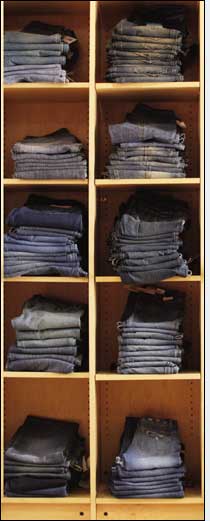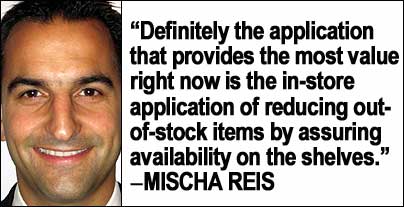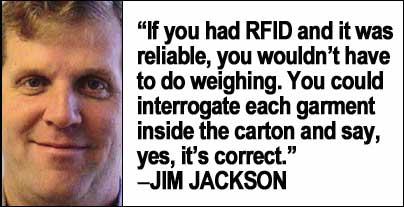It’s the mantra of every clothing and shoe store: have what the customers want, when they want it and where they can buy it.
At two Levi Strauss & Co. stores in Mexico, RFID is helping the clothing retailer realize that goal. Each pair of jeans and every top and jacket is fitted with an RFID transponder embedded in a hangtag along with the bar code and human-readable sales price. Using an interrogator mounted on an inventory pushcart, sales clerks can complete a storewide inventory in about an hour, a process that used to take two days. That inventory data is used on the sales floor to replenish sizes, colors and styles of clothing. During checkout, a scan of the RFID tag, not the bar code, automatically generates an invoice and gathers real-time point-of-sale data so the company knows immediately what products are selling. The RFID tag is removed before the garments leave the store, to alleviate any concerns consumers may have about RFID being used to invade their privacy.
|
|
Levi says the in-store use of item-level RFID on clothing in Mexico City, which started in 2005, has increased sales. While Levi isn’t yet releasing detailed sales figures, the pilot has been so successful that company officials are considering expanding their RFID efforts. Levi Strauss spokesman Jeffrey Beckman said the company is providing RFID-tagged men’s jeans to one retail client for use in a pilot in one U.S. store that seeks to replicate the in-store inventory management success Levi has experienced in Mexico.
“We have highly assorted merchandise,” says Derek Kaufman, Levi’s IP enterprise architect. Levi jeans come in different styles, colors and sizes, as well as different waist measurements and lengths. “When you can inventory at that level of granularity,” Kaufman says, “that’s where the case gets strong for RFID.”
Unlike the consumer packaged goods industry, which has been focused on using RFID to track pallets and cases of goods through the supply chain, the apparel and footwear industry believes that it will realize more benefits from tagging at the item level. Apparel retailers need to manage a larger number of stock-keeping units, and the price of individual garments is far greater than for, say, a roll of toilet paper.
Item-level tagging also could help retailers make sure that new clothing and shoes are on the sales floor and generate point-of-sale data so items that are selling quickly can be replenished from the back room or distribution center.
With fashion, timing is everything. “Spring or summer goods have only a certain selling season to them,” says Stephen Bogart, RFID strategist at Kurt Salmon Associates, a management consulting firm. Garments have a short shelf life, a period from 20 to 40 days before they see their first markdown. If a carton of seasonal clothing is misplaced in the back room and retailers miss the window for displaying the items, it will impact their profit margin because the goods will have to be marked down by 30 percent or so.
In December, Kurt Salmon released a study of item-level RFID in apparel and footwear in conjunction with the American Apparel & Footwear Association (AAFA) and the Voluntary Interindustry Commerce Standards Association (VICS). The report concluded that the return on investment for improving accuracy, visibility and efficiency at the store level could fully justify the cost of RFID- tagging garments and footwear at the distribution center.
Retailers Step Up
The case for item-level tagging in the fashion industry is bolstered by the fact that, on average, 60 percent to 70 percent of customers who go shopping for something specific in apparel don’t find what they are looking for, Bogart says. Customers will either substitute the brand at that store or—in the worst outcome for the retailer—they will go shop at a competitor. Bogart says he has seen pilots in which the use of item-level RFID reduces out-of-stock items on the sales floor by more than 30 percent.
A Japanese pilot in the ladies shoe department of Mitsukoshi’s flagship store in Tokyo found that tagging shoe boxes or individual pairs of shoes cut in half the time consumers have to wait while a sales associate slips into the back room to look for a certain style and size, according to a study by Kurt Salmon. The pilot, which ran from October 2004 to February 2005, involved tagging 13 different brands and 6,500 pairs of shoes. The shoes were tracked when tags were read at several points: by interrogators at the distribution center, handheld interrogators in the back room and stationary interrogators at the checkout counter.
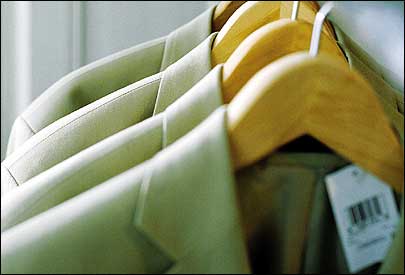
The study found that RFID helped increase the number of shoes associates could show customers, from 1.8 pairs to 3 pairs every 12 minutes. It also enabled the store to send demand signals back to the manufacturer more quickly, to keep shoes in stock. Sales were increased by 10 percent per day. With such results, the pilot quickly spread to full-scale deployment in the shoe departments of five of Mitsukoshi’s largest stores.
The Mitsukoshi success story is not unique. Marks & Spencer (M&S), the U.K. clothing, food and home-products retailer, started exploring RFID tagging of apparel back in 2003. After a year-long trial involving item-level RFID tracking of men’s suits in nine of its stores, M&S announced that it will expand the RFID trial to 53 stores and five other clothing departments starting this spring. The company deployed RFID primarily for inventory control. Each garment is fitted with a hangtag that contains an RFID tag in addition to a bar code and other price information. M&S has pushed the application of those tags back to 25 suppliers in 20 different countries.
“Definitely the application that provides the most value right now is the in-store application of reducing out-of-stock items by assuring availability on the shelves,” says Mischa Reis, marketing director for Avery Dennison Retail Information Services. “If you need to make sure you have enough Coke on a store shelf, you check the 20-ounce bottles or the 12-ounce cans and replenish those. In apparel, you want to make sure that the jeans in size 32 x 30 in blue in a certain style are on the shelves. But there are hundreds of jeans and they all look the same on the shelves.”
Keeping track of inventory is difficult for clothing and shoe retailers, and the problem is compounded by customers’ shopping habits. They try on garments and leave them in the fitting rooms, and they move apparel around racks and departments while shopping. And when they buy merchandise, the store doesn’t have an immediate accounting of what sold, so that the item can be replenished quickly from the back room.
Most retailers don’t have enough employees to repeatedly inventory stock. They typically pay an outside firm to conduct a thorough physical inventory at least twice per year. The inventories most often involve bar-code scanning, which means that every item must be physically handled. Some stores close their doors to conduct an inventory, or at a minimum, cordon off a department. The result can be lost sales.
With RFID, the automatic capture of the item-level information makes taking inventory not only faster but also more accurate. With a bar-code scanner, says Levi’s Kaufman, workers might scan the first item in a stack five times, rather than the bar code on each pair of jeans. “Everybody thinks their inventories are accurate,” Kaufman says. “The fact of the matter is they are not. Even if they are numerically accurate, they are not in terms of size, color and style.”
Manufacturers Tread Lightly
The distribution center has become the point in the apparel supply chain where many RFID adopters, such as Levi, are currently tagging items. As companies increase the number of goods tagged and the number of stores RFID-enabled, that tagging is likely to be pushed back in the supply chain to manufacturing. The cost of hand-applying tags at the distribution center can be far more expensive than applying them at the point of manufacturing, usually overseas, where hangtags and wash labels are already being applied. Nearly 97 percent of apparel sold in the United States is manufactured overseas, most often in Asia or Latin America, according to the AAFA.
The way manufacturers typically store and distribute pieces of apparel is not necessarily at case level,” says Anthony Bigornia, solution manager for IBM’s consumer products industry practice. “They might receive apparel by the case load from their supplier, but at some point they break down those cases of products and store and replace them in a lower measurement of case.” For example, when a manufacturer ships a case of product to the retail DC, instead of holding 24 white shirts, as it received from the supplier, it may repack the case to hold eight red, eight blue and eight white shirts.
VF Corp.—maker of Lee, Riders, Rustler and Wrangler jeans in addition to JanSport backpacks, The North Face outdoor gear and apparel, Nautica sportswear, and lingerie labels such as Vanity Fair—and many other apparel and footwear companies under retailer mandates are trying to figure out how to realize an ROI from RFID. VF came under mandates from Wal-Mart in January 2005 and, about six months later, from Target, to start tagging pallets and cases of merchandise supplied to their stores.
The company saw few internal benefits. Unlike the CPG industry, where products are “picked” by the case or pallet for shipment to stores, the apparel industry combines different types of garments in different styles and sizes. “The cases we ship to Wal-Mart don’t physically exist until two hours before going out the door,” says Jim Jackson, VF’s director of vendor relationship management. “From an operational perspective, there’s no benefit.”
VF is preparing to test RFID tagging at the item level this year to see if the company can find additional efficiencies in the supply chain and in its 350 retail stores. One of the first business cases Jackson says the company will look at is identifying process change, reduction of labor and reduction of handling at distribution centers. “We can’t see inside the cases to ensure they are picked correctly,” Jackson says. “We have to open cases during receiving to validate that our suppliers sent us what they said they would ship.”
VF now gets around viewing the contents of cases by weighing goods to determine whether a shipment contains a specified number of garments. “They know that if the order is for four pair of jeans in these sizes and three pair of this other style in these sizes, it should weigh about this much,” Jackson says. But weight is sometimes unreliable because, for example, humidity can change the weight of certain garments. “If you had RFID and it was reliable, you wouldn’t have to do weighing,” he adds. “You could interrogate each garment inside the carton and say, yes, it’s correct.”
Designers Fight Back
Many designer labels in the fashion trade are looking at RFID as a possible way to reduce counterfeiting by providing verification and authentication, similar to the item-level tagging of pharmaceuticals. During the month of November, U.S. Customs and Border Protection agents seized more than $11.4 million in counterfeit handbags and clothing being smuggled into U.S. ports. They apprehended handbags shipped from China bearing the phony trademarks of such brands as Burberry, Coach, Fendi and Louis Vuitton. They also confiscated shipments of men’s T-shirts, polo shirts, pants and sports shoes carrying fake Nike labels and trademarks.
John Seaner, senior director of industry development for EPCglobal US, says a task force has been established by apparel companies and VICS, to discuss the functionality and business processes that could be improved with item-level RFID. The interest has been high from some of the premier European labels, such as Chanel, Fendi and Gucci in addition to U.S. brands, such as Nike and Ralph Lauren. “They’ve said, ‘Our real interest has nothing to do with in-store applications,'” Seaner says. “‘We don’t care about that as much as we don’t want to see our [counterfeited] products being sold on the streets of New York.'”
Many luxury apparel brands are keeping their interest in RFID as an anticounterfeiting tool close to the vest so as not to tip their hand to those involved in the pirated-goods trade. But analysts say it is one of the more promising areas in which RFID can bring potential financial returns to high-end apparel and shoe brands.
Many of these companies also think that tracking items in stores can help to reduce the nearly 2 percent product shrink rate in apparel and footwear, the rate at which goods are lost or stolen. According to the 2004 National Retail Security Survey conducted by the University of Florida, shoplifting accounts for 34 percent of all retail losses, which amounts to $10.5 billion annually. Employee theft is the largest cause of shrinkage at more than 47 percent.
RFID tags could be a more effective theft deterrent than Electronic Article Surveillance tags, the magnetic tags attached to expensive shoes and garments in stores that trigger an alarm at exit doors if they haven’t been removed when the item was purchased. One potential application is stationing an RFID interrogator at the door to the fitting room so sales associates have a better monitor of how many items a customer carries in—and leaves with, Bogart says. RFID interrogators could also be posted at exit doors, but instead of only alerting staff that something was shoplifted, they would record the data of exactly what was missing. “When something is stolen, they get hit twice,” Bogart says. “Not every store will chase a thief off the sidewalk. They don’t want employees to suffer bodily injury. So they know something was stolen, but they don’t know what was stolen. There’s a hole on the floor and they don’t know what it is.”
Fashion Forward
Te Kurt Salmon study found that stores could gain more insight into what was produced and shipped from factories if RFID was applied during manufacturing. It also could help suppliers adjust the production of fast-selling items that need to be replenished. A more advanced RFID implementation scenario involves not only store-level applications and tagging at the point of production, but automatic replenishment for stores, distribution centers and other locations based on inventory velocity and sell-through data. The study found that this was currently an expensive proposition for companies, and it recommended that they instead focus on store-level applications.
When companies start to realize increased sales as a result of using item-level RFID at the store level, it’s only a matter of time before other apparel and shoe retailers follow suit. “There’s no reason why every retailer of apparel, but especially vertical integrated specialty chains like Aeropostale and Talbots, shouldn’t be marching full steam ahead,” says Marshall Kay, an RFID specialist and retail strategist for Kurt Salmon. “There are so many benefits within the store, starting with the timely back-room to front-room replenishment and increases in the accuracy of perpetual inventory data. Those benefits alone easily justify the initial investment costs.”
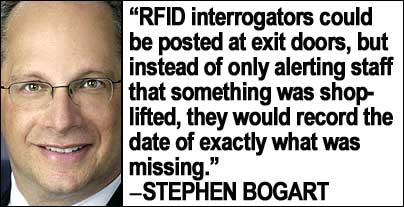
Others in the apparel industry are interested in incorporating RFID tags into garments or shoes as an anticounterfeiting tool. Seaner says the industry is actively discussing how consumers will react if tags are permanently incorporated into garments.
The early results from the Levi pilot—as well as item-level tagging pilots at Japanese retailer Mitsukoshi and U.K. retailer Marks & Spencer—are “making it compelling for everyone to start implementing,” says John Kovac, vice president of supply chain operations for Liz Claiborne, the apparel manufacturer that owns more than 600 specialty stores and outlets worldwide in addition to supplying goods sold in department stores. For several months now, Liz Claiborne has been studying the use of RFID in a lab to determine which business cases make the best sense.
One of the issues holding the company back is whether consumers in the United States will be as accepting of the privacy trade-offs as consumers have been in the United Kingdom and Japan. “How accepted is it going to be? What do we need to do from a disclosure perspective in a store to make sure people are comfortable?” Kovac says. “I don’t think there’s a consensus yet. But there’s a lot of discussion.”

